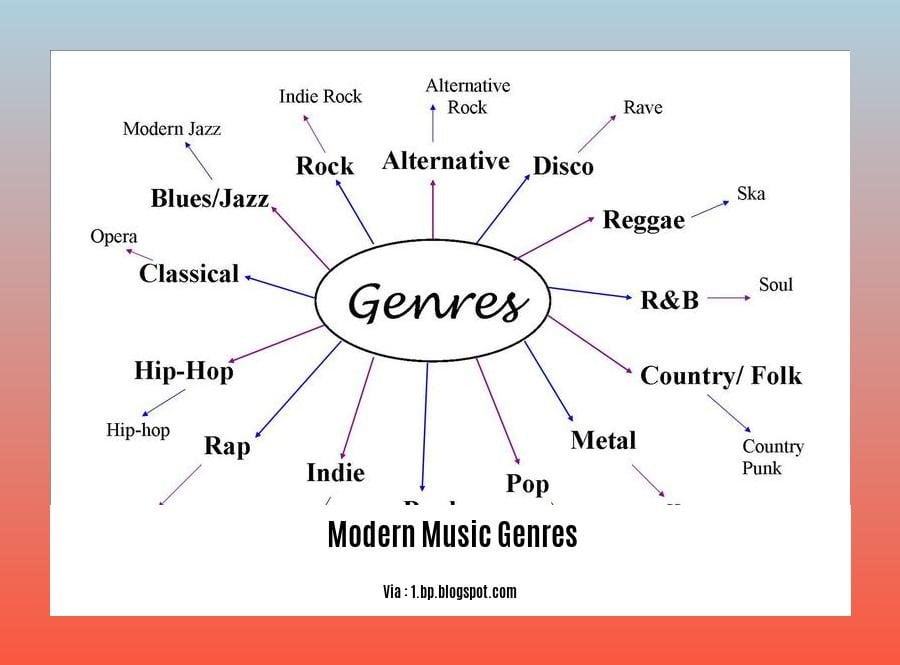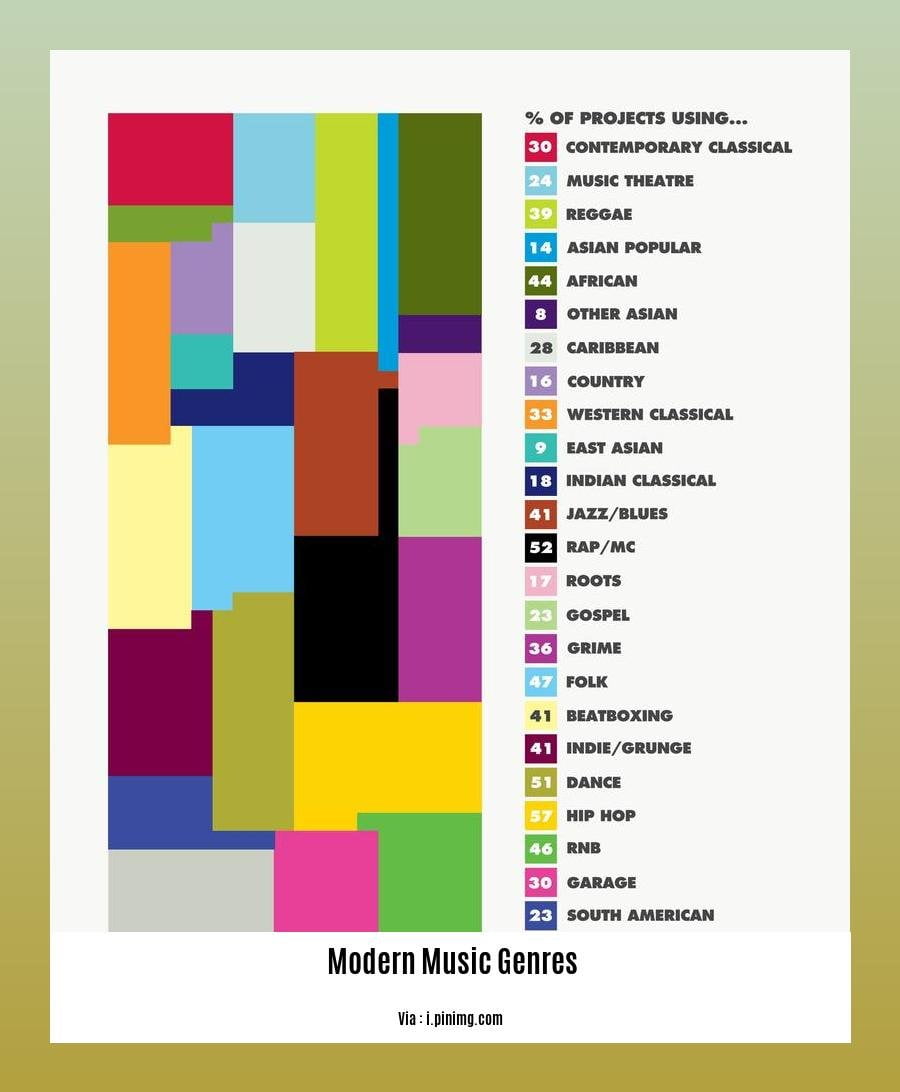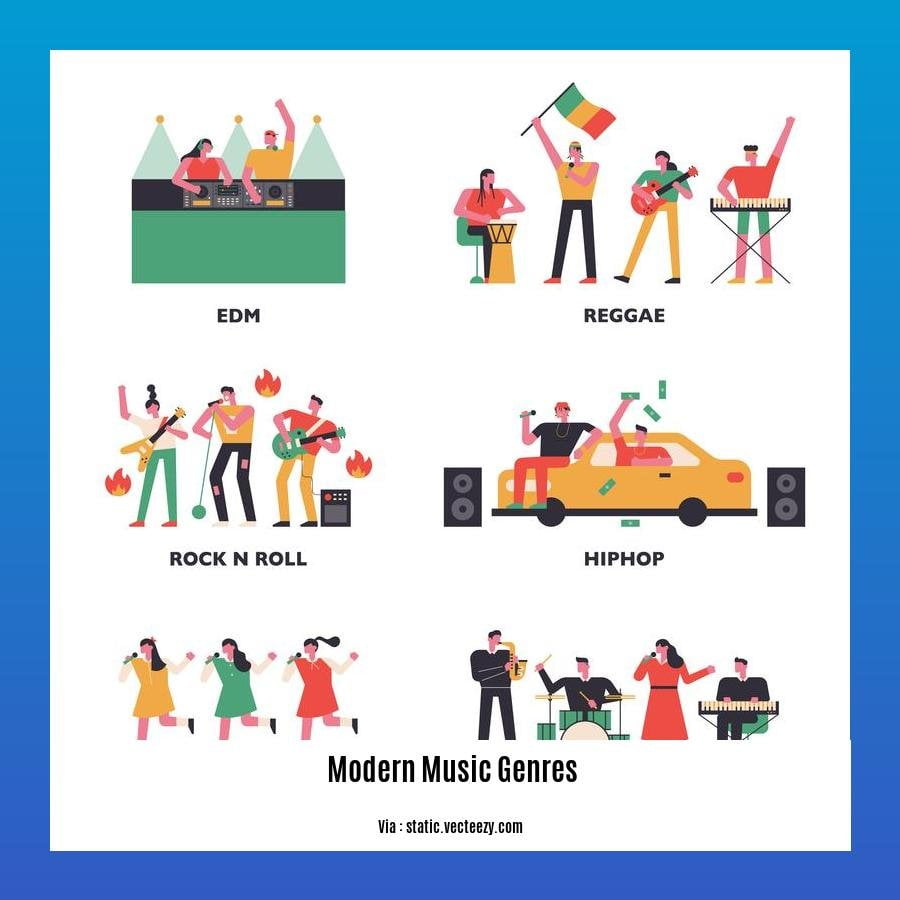Immerse yourself in the captivating world of modern music genres in our comprehensive guide, “[- The Ever-Evolving Tapestry of Modern Music Genres].” Embark on a journey through the labyrinthine tapestry of musical styles, where innovation meets tradition.
Key Takeaways:
- Modern music genres represent a diverse range of styles and influences.
- Popular genres include pop, jazz, rock, alternative, country, electronic, rap, R&B, heavy metal, punk, techno, and house.
- Subgenres within genres contribute to the richness and variety of musical expression.
Modern Music Genres: A Symphony of Styles

The tapestry of modern music genres is as vast and vibrant as the world we live in. From the upbeat rhythms of pop to the soulful melodies of jazz, each genre reflects a unique set of influences and preferences, making it an essential part of our cultural experience.
Jazz, the genre of improvisation and experimentation, fuses elements of African, European, and American music. Its subgenres include swing, bebop, and cool jazz, each with its own distinct flavor.
Rock is a genre characterized by strong vocals, electric guitars, and energetic performances. Its major subgenres include classic rock, alternative rock, and heavy metal, each with its own loyal fanbase.
Country music, steeped in rural traditions and storytelling, features twanging guitars, fiddle, and banjo. Its subgenres include bluegrass, honky-tonk, and country pop, all of which have their own unique charm.
Electronic dance music (EDM), a genre dominated by synthesizers and drum machines, captivates audiences with its infectious beats and hypnotic melodies. Its subgenres include techno, house, and trance, each with its own tempo and energy level.
Hip-hop, a genre born on the streets, combines rapping over a rhythmic beat. Its subgenres include gangsta rap, trap, and conscious rap, each with its own message and style.
The diversity of modern music genres is a testament to the boundless creativity of human expression. These genres not only provide a soundtrack to our lives but also connect us to different cultures and perspectives.
Discover the intricate history of music, from its ancient roots to modern-day genres.
Unravel the development of musical notation, a system that transformed music-making into an artform.
Embark on a journey through the classical music era, characterized by its elegance and refinement.
The Cultural and Social Impact of Modern Music Genres

Modern music genres are a vibrant tapestry, each thread reflecting a unique cultural perspective. As these genres evolve, they shape social norms, influence trends, and connect people across boundaries.
The Cultural Crucible
The cultural impact of music is profound. Genres like hip-hop, with its emphasis on storytelling and social commentary, have become platforms for marginalized voices to amplify their experiences. Electronic dance music (EDM) transports listeners to immersive, sensory worlds, fostering a sense of community and escapism.
Social Connections
Music also serves as a powerful social glue. Shared musical tastes create bonds between individuals, fostering a sense of belonging and identity. Concerts and festivals become melting pots where diverse cultures converge, bridging gaps and promoting understanding.
Shaping Trends
Modern music genres influence fashion, art, and even language. The aesthetics of hip-hop and rock have permeated popular culture, from clothing to hairstyles. The vocabulary of EDM and rap has injected new words and phrases into our everyday lexicon.
Key Takeaways:
- Modern music genres reflect and shape cultural perspectives.
- Hip-hop empowers marginalized voices, while EDM fosters community and escapism.
- Music creates social connections, bridging gaps between diverse cultures.
- Modern music genres influence trends in other cultural domains, including fashion and language.
Sources:
- Cultural Divergence in Popular Music
- Novelty and Cultural Evolution in Modern Popular Music
The Role of Technology in Shaping Modern Music Genres
Technology’s Impact on the Soundscape
Innovative Techniques: Technology has revolutionized the way music is created, enabling musicians to explore new sonic landscapes through digital editing, MIDI, synthesis, and virtual instruments.
Production Transformation: The digital revolution has shifted music production from analog recording to a digital realm, allowing for greater precision, flexibility, and experimentation.
Evolution of Distribution: Online retailers and streaming platforms have transformed music distribution and consumption, making it more accessible and portable than ever before.
Future Frontiers: Artificial intelligence, machine learning, and augmented/virtual reality are on the horizon, promising even more innovative and immersive musical experiences.
Key Takeaways:
- Technology is a catalyst for innovation, shaping the sonic characteristics and production techniques of modern music genres.
- Digital tools empower musicians to push creative boundaries and explore new musical possibilities.
- Technology is redefining music consumption and distribution, creating a more accessible and globalized musical landscape.
Relevant Sources:
Importance of Technology in the Music Industry
How Technology is Transforming the Future of Music
The Future of Modern Music Genres
The future of modern music genres is a fascinating topic that keeps music enthusiasts and industry experts on the edge of their seats. With the constant evolution of technology and the convergence of various cultural influences, the musical landscape is undergoing a profound transformation.
Paradigm Shifts:
- Technological Innovations: Advances in music production software, virtual instruments, and AI have empowered artists to create new and experimental sounds.
- Globalization: The internet and social media have broken down geographical barriers, fostering collaborations between musicians from diverse backgrounds.
- Cultural Fusion: Influences from different cultures are merging, creating a hybrid music style that defies traditional boundaries.
Emerging Trends:
- Vaporwave: This genre evokes nostalgia for the 1980s and 1990s, with a vaporous and ethereal sound.
- Seapunk: A blend of electronic dance music and aquatic themes, capturing the essence of the ocean.
- Witch House: A dark and atmospheric electronica subgenre that incorporates elements of hip-hop and synthpop.
- Synthwave: A retro-futuristic take on electronic music, paying homage to the soundtracks of classic films and video games.
- Dubstep: A high-energy dance genre characterized by heavy basslines and syncopated rhythms.
Key Takeaways:
- Technology is a catalyst for musical innovation and experimentation.
- Globalization and cultural fusion are driving the creation of unique and hybrid genres.
- Emerging trends like vaporwave, seapunk, witch house, synthwave, and dubstep are shaping the future of music.
Citations:
- The Future of Music Genres: How Technology and Globalization Are Shaping the Sound of Tomorrow
- The Sound of Tomorrow: 15 Innovative Music Genres to Know
FAQ
Q1: What are the defining characteristics of modern music genres?
Q2: How are modern music genres influenced by cultural evolution and technology?
Q3: What are some significant subgenres of modern music genres?
Q4: How can we anticipate the future of music genres?
Q5: What factors shape the diversity and innovation of modern music genres?
- China II Review: Delicious Food & Speedy Service - April 17, 2025
- Understand Virginia’s Flag: History & Debate - April 17, 2025
- Explore Long Island’s Map: Unique Regions & Insights - April 17, 2025
















